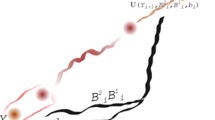Abstract
The paper presents a complete and general representation of the overall efficiency expression for the quantum secure direct communication (QSDC) protocol that relies on quantum channel compression (QCC). For this purpose, (i) the encoding technique, respectively, QCC is generalized—QCCs of higher order are introduced; (ii) the data statistics of the messages to be transferred are incorporated into the overall efficiency expression. An analysis is made concerning the behavior and the extent of the overall efficiency. It is justified that QSDC protocols, which are based on high order of QCC, could achieve efficiencies that have never been reached before.


Similar content being viewed by others
Explore related subjects
Discover the latest articles and news from researchers in related subjects, suggested using machine learning.Notes
Binary symbol of length n (n-bit symbol)-binary sequence comprised of n number of binary digits (zeros and ones) (e.g., 01—binary symbol of length two).
Bitwise inverse—two binary symbols are bitwise binary inverse when their binary digits are opposite to each other (e.g., 00–11, or 10–01).
References
Bebrov, G.: Efficient quantum secure direct communication protocol based on quantum channel compression. QIP, QINP-D-18-00460 (under review)
Huffman, D.: A method for the construction of minimum-redundancy codes. Proc. IRE 40, 1098 (1952)
Long, G.L., Liu, X.S.: Theoretically efficient high-capacity quantum-key-distribution scheme. Phys. Rev. A 65, 032302 (2002)
Long, G.L., Deng, F.G., Wang, C., Li, X., Wen, K., Wang, W.: Quantum secure direct communication and deterministic secure quantum communication. Front. Phys. 2, 251 (2007)
Deng, F.G., Long, G.L., Liu, X.S.: Two-step quantum direct communication protocol using the Einstein–Podolsky–Rosen pair block. Phys. Rev. A 68, 042317 (2003)
Wang, C., Deng, F., Li, Y., Liu, X., Long, G.: Quantum secure direct communication with high-dimension quantum superdense coding. Phys. Rev. A 71, 044305 (2005)
Banerjee, A., Pathak, A.: Maximally efficient protocols for direct secure quantum communication. Phys. Lett. A 376, 2944 (2012)
Tsai, C.W., Hsieh, C.R., Hwang, T.: Dense coding using cluster states and its application on deterministic secure quantum communication. Eur. Phys. J. D 61, 783 (2011)
Deng, F., Long, G.: Secure direct communication with a quantum one-time pad. Phys. Rev. A 69, 052319 (2004)
Deng, F., Li, X., Li, C., Zhou, P., Zhou, H.: Quantum secure direct communication network with Einstein–Podolsky–Rosen pairs. Phys. Lett. A 359, 359 (2006)
Joy, D., Surendran, S., Sabir, M.: Efficient deterministic secure quantum communication protocols using multipartite entangled states. QIP 16, 1 (2017)
Acknowledgements
The work is supported by the projects ДН07/10-2016 and ПД01/05-2018, funded by National Science Fund, Ministry of Education and Science, Bulgaria.
Author information
Authors and Affiliations
Corresponding author
Additional information
Publisher's Note
Springer Nature remains neutral with regard to jurisdictional claims in published maps and institutional affiliations.
Rights and permissions
About this article
Cite this article
Bebrov, G. On the generalization and improvement of QSDC efficiency achieved through a quantum channel compression. Quantum Inf Process 18, 115 (2019). https://doi.org/10.1007/s11128-019-2227-4
Received:
Accepted:
Published:
DOI: https://doi.org/10.1007/s11128-019-2227-4




